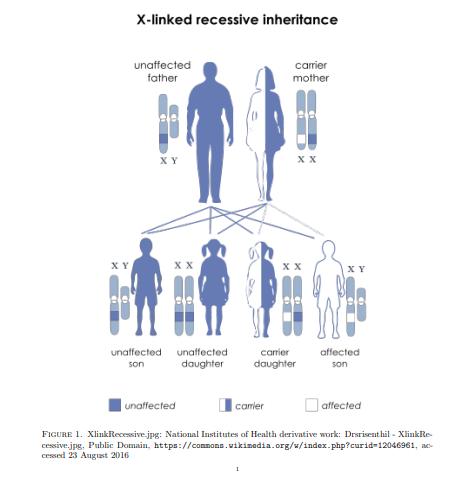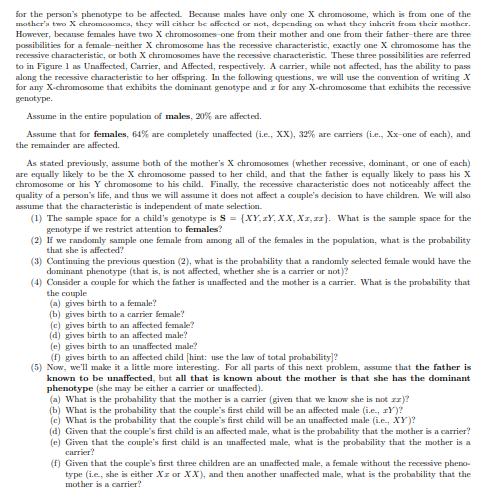Answered step by step
Verified Expert Solution
Question
1 Approved Answer
For the next several questions, refer to Figure 1. As a quick and overly simplistic biology review, note the following information. The genetic makeup



For the next several questions, refer to Figure 1. As a quick and overly simplistic biology review, note the following information. The genetic makeup of our chromosomes (i.e., the genotype) impacts our physical characteristics (or more precisely, the phenotype). Genetically, males have an X chromosome and a Y chromosome. Females have two X chromosomes. When a couple has a child, we'll assume the father is equally likely to pass along his X or his Y chromosome to the child. We'll also assume that the mother is equally likely to pass along either of her X chromosomes. For an X-recessive characteristic (phenotype), all X chromosomes must have the recessive genotype. XY 88 X-linked recessive inheritance unaffected father 20 XY unaffected son XX unaffected. daughter unaffected carrier mother camer carrier daughter XX XX XY affected son affected FIGURE 1. XlinkRecessive.jpg: National Institutes of Health derivative work: Drsrisenthil - XlinkRe cessive.jpg, Public Domain, https://commons.wikimedia.org/w/index.php?curid-12046961, ac cessed 23 August 2016 for the person's phenotype to be affected. Because males have only one X chromosome, which is from one of the mother's two X chromosomes, they will either be affected or not, depending on what they inherit from their mother. However, because females have two X chromosomes-one from their mother and one from their father-there are three possibilities for a female-neither X chromosome has the recessive characteristic, exactly one X chromosome has the recessive characteristic, or both X chromosomes have the recessive characteristic. These three possibilities are referred to in Figure 1 as Unaffected, Carrier, and Affected, respectively. A carrier, while not affected, has the ability to pass along the recessive characteristic to her offspring. In the following questions, we will use the convention of writing X for any X-chromosome that exhibits the dominant genotype and z for any X-chromosome that exhibits the recessive genotype. Assume in the entire population of males, 20% are affected. Assume that for females, 64% are completely unaffected (i.e., XX), 32% are carriers (ie., Xx-one of each), and the remainder are affected. As stated previously, assume both of the mother's X chromosomes (whether recessive, dominant, or one of each) are equally likely to be the X chromosome passed to her child, and that the father is equally likely to pass his X chromosome or his Y chromosome to his child. Finally, the recessive characteristic does not noticeably affect the quality of a person's life, and thus we will assume it does not affect a couple's decision to have children. We will also assume that the characteristic is independent of mate selection. (1) The sample space for a child's genotype is S = (XY.Y. XX. X,zz). What is the sample space for the genotype if we restrict attention to females? (2) If we randomly sample one female from among all of the females in the population, what is the probability that she is affected? (3) Continuing the previous question (2), what is the probability that a randomly selected female would have the dominant phenotype (that is, is not affected, whether she is a carrier or not)? (4) Consider a couple for which the father is unaffected and the mother is a carrier. What is the probability that the couple (a) gives birth to a female? (b) gives birth to a carrier female? (c) gives birth to an affected female? (d) gives birth to an affected male? (e) gives birth to an unaffected male? (f) gives birth to an affected child [hint: use the law of total probability]? (5) Now, we'll make it a little more interesting. For all parts of this next problem, assume that the father is known to be unaffected, but all that is known about the mother is that she has the dominant phenotype (she may be either a carrier or unaffected). (a) What is the probability that the mother is a carrier (given that we know she is not zz)? (b) What is the probability that the couple's first child will be an affected male (i.e., Y)? (e) What is the probability that the couple's first child will be an unaffected male (i.e., XY)? (d) Given that the couple's first child is an affected male, what is the probability that the mother is a carrier? (e) Given that the couple's first child is an unaffected male, what is the probability that the mother is a carrier? (f) Given that the couple's first three children are an unaffected male, a female without the recessive pheno- type (ie, she is either Xz or XX), and then another unaffected male, what is the probability that the mother is a carrier?
Step by Step Solution
★★★★★
3.45 Rating (152 Votes )
There are 3 Steps involved in it
Step: 1
1 Since the sample space for S XY NY XX Xx xx 3 Then the sample space for the female genotype is S X...
Get Instant Access to Expert-Tailored Solutions
See step-by-step solutions with expert insights and AI powered tools for academic success
Step: 2

Step: 3

Ace Your Homework with AI
Get the answers you need in no time with our AI-driven, step-by-step assistance
Get Started


